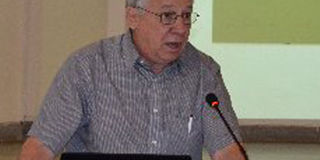Breaking News: KDF chopper crash kills five in West Pokot
Now your phone can tell how to use fertiliser for more profit

Prof Wortmann PHOTO BY ISAIAH ESIPISU|NATION
What you need to know:
- Scientists have developed a computer system to boost the use of fertiliser and maximise profits.
- The tool, which can also be used on mobile phone, considers the amount of money a farmer has and shows him how much of fertiliser should be applied to every crop for maximising profit.
- It considers the estimated value of the farm produce price in shillings against the amount of fertiliser used. In addition to giving the fertiliser rates for each crop, it estimates average yield and net return increases for each crop.
- The tool has been rolled out in Uganda through the country’s national research institution known as National Agricultural Research Organisation
Scientists have developed a computer system to boost the use of fertiliser and maximise profits.
After two years of field research, the Kenyan scientists in collaboration with their colleagues from 12 other African countries and the University of Nebraska-Lincoln in the US, came up with the computer-based fertiliser use decision tool.
The tool, which can also be used on mobile phone, considers the amount of money a farmer has and shows him how much of fertiliser should be applied to every crop for maximising profit.
The Ms Excel-based programme, also known as Fertiliser Optimisation Tool (FOT), uses data derived from previous and recent field research in major crop producing agro-ecological zones.
Value for money
It considers the estimated value of the farm produce price in shillings against the amount of fertiliser used. In addition to giving the fertiliser rates for each crop, it estimates average yield and net return increases for each crop.
“Our main aim is to maximise on net returns according to the amount of fertiliser that the farmer can afford. The field research is needed to determine the mathematical functions that represent a crop’s response to an applied fertiliser. These mathematical functions, therefore, underlie the mechanics of the FOT,” Prof Charles Wortmann, a soil fertility expert from University of Nebraska told Seeds of Gold.
The system, which is already being used in Uganda, is being implemented in all important crop producing areas of Kenya.
In total, 65 agro-ecological zones of 13 African countries will benefit from the system.
If a farmer has an acre, for instance, and can only afford to buy fertiliser worth Sh3,000, then the system will advise on the fertiliser type and amount to be applied to each crop that he wants to plant for maximising profit from the investment in fertiliser use.
The fertiliser use decision process, according to Prof Wortmann, considers the type of the soil, its fertility, and availability of nutrients from other sources such as manure to determine which type of fertiliser to be applied, and in what quantities, but based on what the farmer can afford.
Soil management
However, the experts encourage the use of fertiliser in combination with other soil fertility management methods such as use of manure, growing leguminous plants and liming where the soils are acidic to give crops maximum nutrients.
“The profit potential varies greatly with choice of crop-nutrient combination as well as with rate of application,” said Prof Wortmann of the system, whose making was funded by the Alliance for Green Revolution in Africa (AGRA), with the Centre for Agriculture and Bioscience International (CABI) as the implementing partner.
The tool has been rolled out in Uganda through the country’s national research institution known as National Agricultural Research Organisation.
“The Uganda case is a huge success story, and that’s why we are keen to have the tool developed for many other agro-ecological zones in 12 more countries including Kenya,” said Dr Bashir Jama, who heads the Farmer Solutions Unit at AGRA.
“It is a tool for smallholder farmers who have very limited resources in terms of money to invest in fertilisers,” said Dr Jama.
Dr Catherine Kibunja, the Principal Investigator for fertiliser optimisation and application of the tool in Kenya, said trials have already been conducted in different agro-ecological zones including Trans Nzoia, Uasin Gishu, Migori, Busia, Mbeere, Murang’a, Machakos and Nakuru.
“Preliminary findings from the trials indicate that decisions made based on the tool increased profitability by up to 200 per cent,” Dr Kibunja, who is also the Coordinator, Soil Fertility and Plant Nutrition Research Programme at the Kenya Agricultural and Livestock Research Organisation in Kabete, told Seeds of Gold.
Dr Kibunja added that training programmes are being rolled out in at least 27 counties to train agricultural extension service providers on how to use the system.
Martha Igoki, a smallholder farmer from Emelia village, Embu County, is one of the farmers who participated in the trials.
After she was given different combinations of fertiliser to use depending on the money she had – Sh4,000, she was advised to plant maize on half acre, pearl millet on another, and green grams on the remaining quarter acre.
“To my surprise, I harvested five 90kg bags of maize, which is the best I have ever seen since I started farming 15 years ago.” said the mother of five children.
“We have always advised farmers to invest in fertilisers for better yields, but that will not work well if they do not realise profits. We are glad that this tool is now able to address profitability derived from fertilisers,” said Dr Kibunja.





